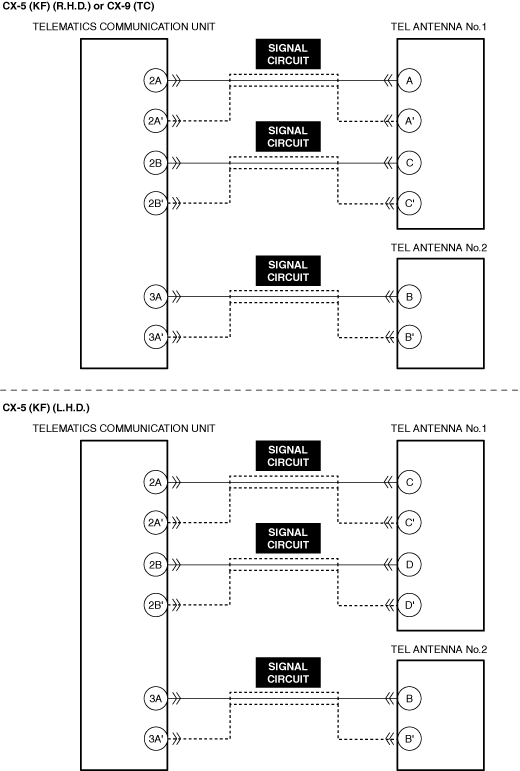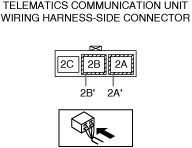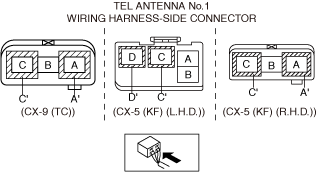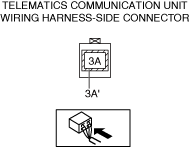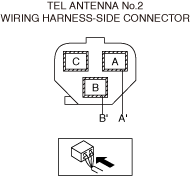|
1
|
VERIFY ALL SYSTEM DTCs
• Perform the DTC inspection. Refer to the [DTC INSPECTION] in the workshop manual.
• Are any DTCs displayed?
|
Yes
|
Repair the malfunctioning location according to the applicable DTC troubleshooting.
|
|
No
|
Go to the next step.
|
|
2
|
INSPECT TELEMATICS COMMUNICATION UNIT, TEL ANTENNA NO.1, AND TEL ANTENNA NO.2 CONNECTORS FOR MALFUNCTION
• Inspect the applicable connector and terminal. Refer to the [CONNECTOR INSPECTION] in the workshop manual.
• Are the connector and terminal normal?
|
Yes
|
Go to the next step.
|
|
No
|
Repair or replace the malfunctioning location and perform the repair completion verification.
|
|
3
|
INSPECT TEL ANTENNA NO.1 SIGNAL CIRCUIT FOR SHORT TO POWER SUPPLY, SHORT TO GROUND, AND OPEN CIRCUIT
• Inspect the signal circuit for a short to power supply, short to ground, and an open circuit. Refer to the [CIRCUIT INSPECTION] in the workshop manual.
• Are the connector and terminal normal?
|
Yes
|
Go to the next step.
|
|
No
|
Repair or replace the malfunctioning location and perform the repair completion verification.
|
|
4
|
INSPECT TEL ANTENNA NO.2 SIGNAL CIRCUIT FOR SHORT TO POWER SUPPLY, SHORT TO GROUND, AND OPEN CIRCUIT
• Inspect the signal circuit for a short to power supply, short to ground, and an open circuit. Refer to the [CIRCUIT INSPECTION] in the workshop manual.
• Are the connector and terminal normal?
|
Yes
|
Go to the next step.
|
|
No
|
Repair or replace the malfunctioning location and perform the repair completion verification.
|
|
Repair completion verification1
|
VERIFY THAT VEHICLE IS REPAIRED
• Install/connect the part removed/disconnected during the troubleshooting procedure.
• Has the malfunction symptom been eliminated?
|
Yes
|
Complete the symptom troubleshooting. (Explain contents of repair to customer)
|
|
No
|
Disconnect the TEL antenna No.1 connector and verify the [radio reception status display for the telematics communication unit].
If the [radio reception status display for the telematics communication unit] indicates out of range:
• Replace the TEL antenna No.2, then go to the next step. Refer to the [TEL ANTENNA REMOVAL/INSTALLATION] in the workshop manual.
If the [radio reception status display for the telematics communication unit] does not indicate out of range:
• Go to the next step.
|
|
Repair completion verification2
|
VERIFY THAT VEHICLE IS REPAIRED
• Install/connect the part removed/disconnected during the troubleshooting procedure.
• Has the malfunction symptom been eliminated?
|
Yes
|
Complete the symptom troubleshooting. (Explain contents of repair to customer)
|
|
No
|
Replace the TEL antenna No.1, then go to the next step.
Refer to the [TEL ANTENNA REMOVAL/INSTALLATION] in the workshop manual.
|
|
Repair completion verification3
|
VERIFY THAT VEHICLE IS REPAIRED
• Install/connect the part removed/disconnected during the troubleshooting procedure.
• Has the malfunction symptom been eliminated?
|
Yes
|
Complete the symptom troubleshooting. (Explain contents of repair to customer)
|
|
No
|
Refer to the controller area network (CAN) malfunction diagnosis flow to inspect for a CAN communication error.
Refer to the [CONTROLLER AREA NETWORK (CAN) MALFUNCTION DIAGNOSIS FLOW [TYPE-B]] in the workshop manual.
If the CAN communication is normal, perform the diagnosis from Step 1.
• If the malfunction is not resolved, replace the telematics communication unit. Refer to the [TELEMATICS COMMUNICATION UNIT REMOVAL/INSTALLATION] in the workshop manual.
|
